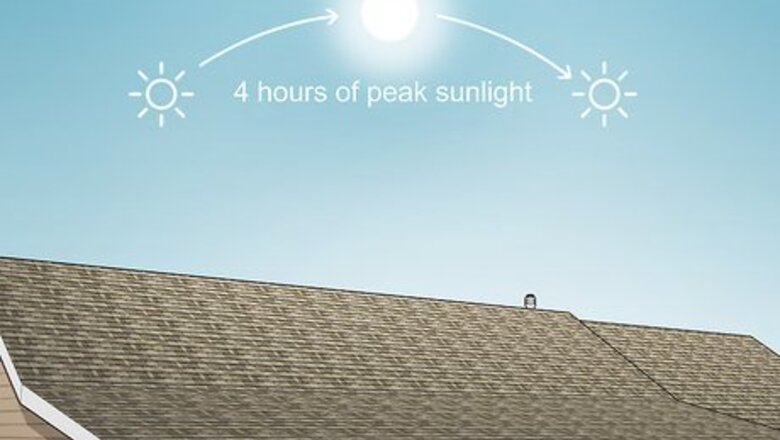
views
- Choose solar panels if your area gets at least 4 hours of sunlight per day. You can install solar panels yourself or have a professional install them for you.
- Try a wind turbine if you live in a flat area with few tall buildings around. Buy a turbine online or from a local company to help with installation.
- Choose a biomass or biogas system if you produce a lot of waste, like wood chips, paper, or sewage.
- Go for a micro-hydro system if you have a stream on your property. Have your property surveyed to make sure this option is right for you.
Solar Panels
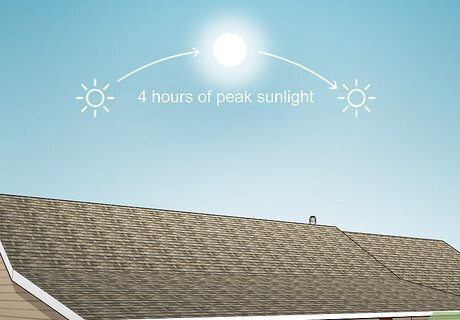
Opt for solar panels if your property gets at least 4 hours per day. Peak sunlight hours occur when the sun is the highest in the sky, and locations closer to the Equator get more peak sun hours than those further away. Look online for a peak sunlight hours map to see how many peak hours your area has. Then, check your property for places that aren’t covered by shade during the day, since solar panels can’t generate electricity if they aren’t exposed to sunlight. Look for solar power companies near you and schedule a consultation. Solar power companies can look at your home and property to determine how efficient solar panels would be. Solar power companies will examine the slope of your roof and the direction that it faces, whether it's north, south, east, or west. These are all variables that will determine how much energy that solar panels could theoretically produce for your home.

Choose a type of solar panel that works best for you. It’s important to choose the right solar panels for your home. The 3 main types of solar panels are monocrystalline, polycrystalline, and thin film. Monocrystalline panels are the most recognizable types and have about 20% efficiency. They take up the least amount of space, but they are the most expensive. Polycrystalline panels are more affordable, but they only have about 16% efficiency and don’t work well in higher temperatures since they have a low heat tolerance. Thin film panels are flexible and the cheapest option, but they are the least efficient at 7-13% and they take up the most space. See if there are any financing options for the solar panels so you can pay them off over a set period of time rather than spending a lot up-front. You can install single solar panels at a time if you can’t afford to buy multiple panels. Sometimes, electric companies offer certain rebates or incentives if you install solar panels. Contact your electric provider and ask them if they offer grants or discounts for solar panel installation.
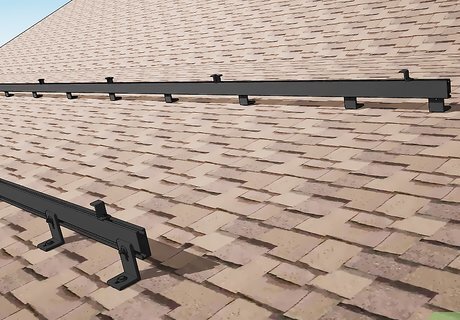
Install a mounting system and an inverter to convert electricity. Once you have your solar panels picked out, you can install the mounting system on your roof or on the ground. Then, attach inverters to the panels to convert the electricity and power your home. If you don’t feel comfortable installing the solar panels yourself, many solar power companies will install the panels for you. Solar panels generate DC power, but inverters convert it to AC power so you can use it in your home.
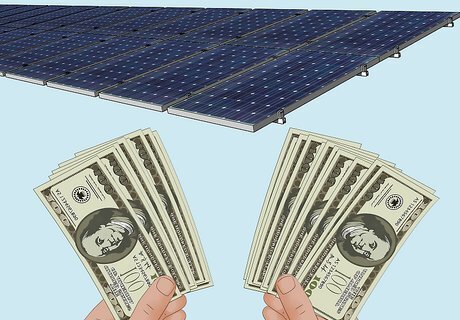
Expect to spend between $15,000 and $20,000 for solar panels. The cost of your solar panels will depend on the size of your property and how much wattage it takes to power your home. On average, though, you can expect to spend around $20,000 upfront. You may be able to work out a payment plan with either the solar panel company or your electric company, so look into your options before paying in full. Any extra electricity you generate can usually be sold back to your electric company, so you may be able to make some extra money over time.
Small Wind System
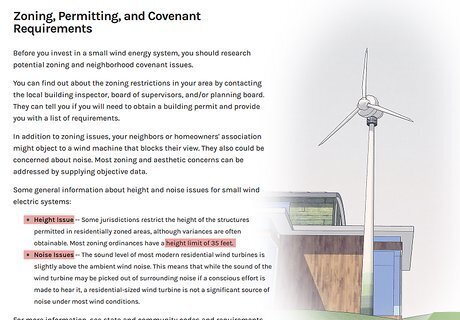
Check the zoning restrictions in your area for the maximum structure height. Since wind systems are tall, you may not be able to install the system in a residential area depending on your zoning requirements. Check with local building inspectors or your city’s homeowner’s association to see if you’re eligible for building a turbine. If zoning isn’t an issue, then you can build a turbine on your property. Many zoning ordinances have a height limit of about 35 feet (11 m), and many wind systems need to be 30 feet (9.1 m) higher than the tallest structure within 500 feet (150 m).
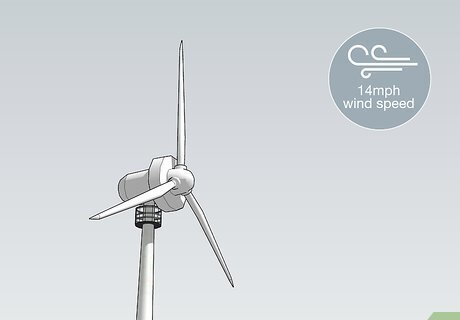
Opt for a turbine if the average wind speed is 14 mph (23 km/h) or more. Look online for wind speed maps or airport wind speed data to see what the average wind speed is in your area. If the average wind speeds are around 14 miles per hour (23 km/h), then a turbine might be an efficient way to generate electricity to power your home. If the wind speed is slower, then you may not get the turbine’s full effectiveness. Wind speeds increase the higher above ground you are. Many airports measure their wind speed from about 30 feet (9.1 m) above ground, which is similar to the height of a residential turbine. Hire a professional who installs wind turbines to check the efficiency and wind speed of your property for you if you have trouble determining it yourself.
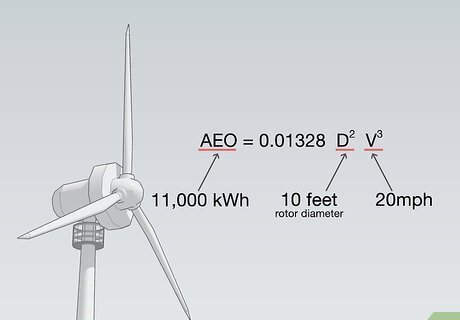
Calculate the minimum diameter for the turbine blades to power your home. Check with your electric company to find out how many kilowatt-hours your home used in the past year. Use the formula AEO = (0.01328)DV, where AEO is your annual energy output in kilowatt-hours per year, D is the diameter of the rotor in feet, and V is the annual average wind speed in miles per hour. Solve the formula for D and buy a turbine system with the correct size rotors. For example, if you use 11,000 kilowatt-hours of electricity per year and the average annual wind speed is 20 miles per hour, your formula would be 11,000 = (0.01328)D(15). If you solve for D, the diameter you need for your system is about 10 feet (3.0 m). Once you know what size turbine you need, purchase one from a local supplier. This company may also be able to supply you with other crucial parts (like the tower) and/or complete the installation. You can also find wind turbines online.
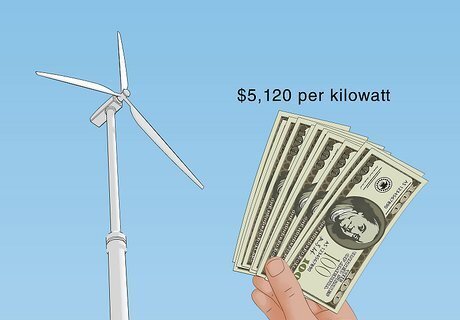
Expect to spend about $5,120 per kilowatt needed. The cost of installing a small wind system depends on the size and the structure you’re going for. However, most people spend about $5,000 for every kilowatt they need to power their home. You can ask a local supplier to provide an estimate for you before you buy.
Biomass or Biogas
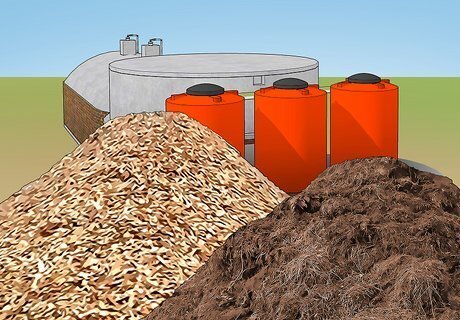
Opt for biomass or biogas if your property produces a lot of waste. When we say “waste,” we’re not talking about garbage: for biomass, things like wood chips, timber offcuts, paper products, old crops, sewage, and animal manure are ideal. Biogas is useful if you’re on a farm that produces a lot of animal waste. Burning these waste materials creates methane and carbon dioxide, which can be used for heating, cooling, and cooking. While methane and carbon dioxide are both greenhouse gasses, burning the methane in a biogas system is better than releasing it into the atmosphere. Typically, it’s more efficient to burn biomass than it is to compost it.
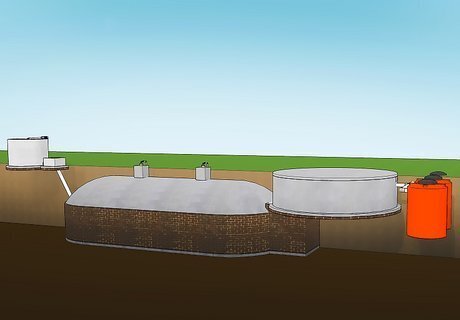
Install a biomass or biogas system on your property. Burning biomass and biogas is one thing, but harnessing the energy from it is another. To use the methane and carbon dioxide that these waste materials produce, look into a biomass or biogas system for your property. Typically, biomass and biogas systems are partially underground. They collect the waste and then burn the off-gas to generate power. The size and installation process depends a lot on the size of your land and where it is, so it’s best to have a professional come take a look and give you an estimate.
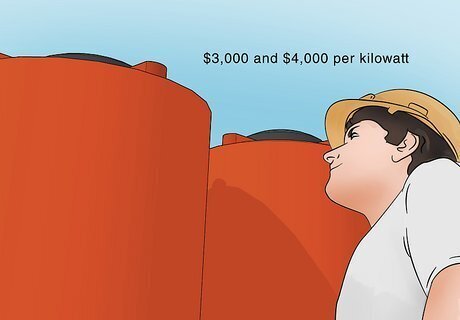
Expect to spend between $3,000 and $4,000 per kilowatt needed. The cost of installation varies greatly depending on the size of your property and the amount of power you need to generate. Fortunately, the upfront cost is typically the most expensive, and maintenance costs are relatively low. Biogas systems are typically slightly more expensive, but they are still around the same range.
Micro-Hydro System

Have your stream inspected by a professional. A micro-hydro system is suitable for properties with an existing stream and water flow. In order to see if your stream is right for a micro-hydro system, hire someone from the U.S. Geological Survey (USGS), the U.S. Army Corps of Engineers, or the U.S. Department of Agriculture to come and take a look at your property. They will measure the “head” (the vertical distance that the water falls) and the “flow” (the quantity of water falling). If you’ve already had surveys done or the previous owner of the property has had them done, contact your local county records office to access those surveys. There are ways to take these measurements yourself; however, they are very complicated and often take multiple seasons to complete. It’s usually much easier just to hire someone to survey your property.
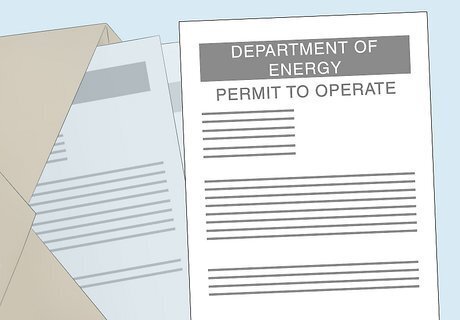
Get a permit from your county. Depending on where you live, you will likely need a permit from your local county’s office to install a micro-hydro dam. You will also need to look into your water rights (who owns the stream that is on your property) and whether or not you can disrupt it with a micro-hydro system. Each state controls their own water rights, and they can vary from state to state. You will also need to factor in the environmental impact of your micro-hydro system. If you have any native species on your property, for instance, that would be impacted by a micro-hydro system, it may not be feasible.
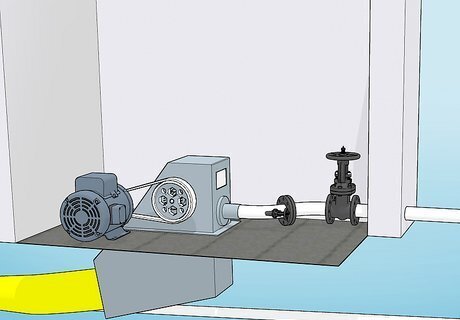
Look for a system that outputs the watts that you’d need. Micro-hydro systems come in different sizes, and you can purchase one that fits your home and your energy output. Ask your electric company how many watts you use in a month, then look for a system that generates slightly more than that. Micro-hydro systems are typically expensive upfront, but they can last for decades and often require little to no maintenance.

Expect to spend between $1,500 and $2,000 per kilowatt. The bigger your micro-hydro system is, the more expensive it is to install. Fortunately, the upfront cost is typically the largest expense—micro-hydro systems usually require very little maintenance over the years. You can keep costs low by reducing your energy consumption to decrease the kilowatts that are needed for your system.
Generators

Use a diesel or biodiesel generator as a backup electricity system. While a generator shouldn’t be your main source of power, they’re very handy to have in case your main home power generation system fails. You can use a portable generator to keep costs low, or you can install a permanent generator for a long-term solution. Keep a diesel generator or biodiesel generator on the property to use in case of an emergency. Generators are fairly simple machines, and they’re easy to maintain. However, they tend to get noisy, and diesel or biodiesel fuel costs can add up.
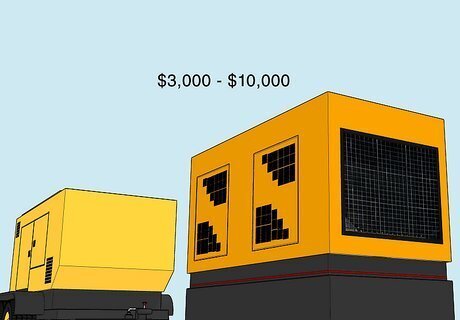
Expect to spend between $3,000 and $10,000 for a generator. A portable generator is the cheapest option, and these are easy to pick up at any hardware store. Installing a permanent generator typically costs a few thousand dollars, depending on how large it is and the size of your home. Diesel generators are slightly more expensive than gas-powered generators. However, diesel generators are more fuel-efficient, so they’re worth the extra cost.

















Comments
0 comment